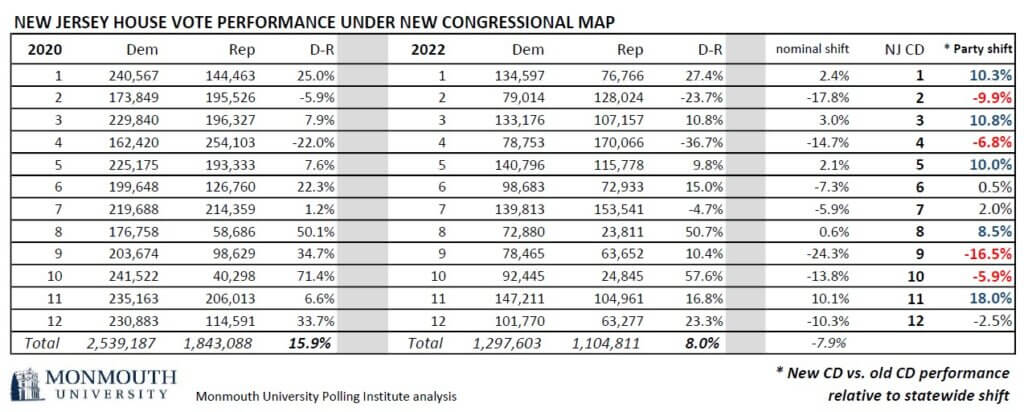by Patrick Murray
I’ve been fielding a lot of “what-if” questions, particularly in light of Rep. Tom Malinowski’s election night comment about the likelihood of having won if it was his old district. So I ran some numbers for a simple “uniform shift” analysis (see table). Put simply, New Jersey Democrats won the cumulative statewide two-party House vote in 2020 by 16 points. They are winning the 2022 total by 8 points – that’s an 8-point shift in the Republican direction. Assuming this shift is uniform across all 12 districts, we can calculate the effect of redistricting on each district. For example, Rep. Norcross won NJ01 by 25 points in 2020 and by 27 points in 2022. That 2-point difference is minimal on the face of it, but when you account for the fact that the statewide vote went down for Democrats, then you can make a simple projection of how he would have performed if the Democratic margin had been as strong this year as it was two years ago. In that analysis, the D-friendlier district lines in the new NJ01 map gave the incumbent a 10-point cushion. In other words, we would have expected Norcross to have won by 17 points this year if he was running in his old district.
There are a lot of caveats to this, including the fact that new district lines mean some voters are unfamiliar with the incumbents. Out-of-power party voters from the old district may not show up because they’ve gotten used to their side not winning elections. However, that can be overcome with strong outreach efforts by these incumbents to their new voters. Still, it’s obvious that New Jersey’s new congressional map gave Dem. CDs 1/3/5/8/11 along with GOP CDs 2/4 sizable cushions over the old map. That came in part by reducing the Democratic advantage in CDs 9/10 (2 of the top 3 Dem. CDs in NJ). CDs 6/7/12 came out about even (i.e., performed about the same as you would have expected them to under the old map).
On the NJ07 question, Malinowski won by one point in 2020 and lost by 5 points in 2022. The “uniform shift” metric suggests he still would have lost his old CD, albeit by a tight margin, everything else being equal (which is a huge caveat). Malinowski may have had a narrow path to victory in his old district, but that argument is purely academic because the lines had to be redrawn. Therefore, a more interesting question – considering the extra D advantage in other districts – is whether Democrats on the redistricting commission could have in fact drawn a 10D-2R map. That’s still not clear. The current map is still pretty funky. You can make an argument that NJ07, by rights, should have been even more Republican because they really contorted it to get it all the way to Linden in Union County. The fact that NJ08 got even more Democratic is also a byproduct of geographic constraints. The concentration of Democratic voters in the urban northeastern part of the state means that CDs 8/9/10 are always going to be very Democratic unless you draw districts with lots of tentacles that likely would violate other principles of redistricting (such as diluting the voting power of specific ethnic/racial groups). That’s a larger philosophical and strategic question which we’ve got nearly a decade to ponder until the next redistricting cycle comes around.

